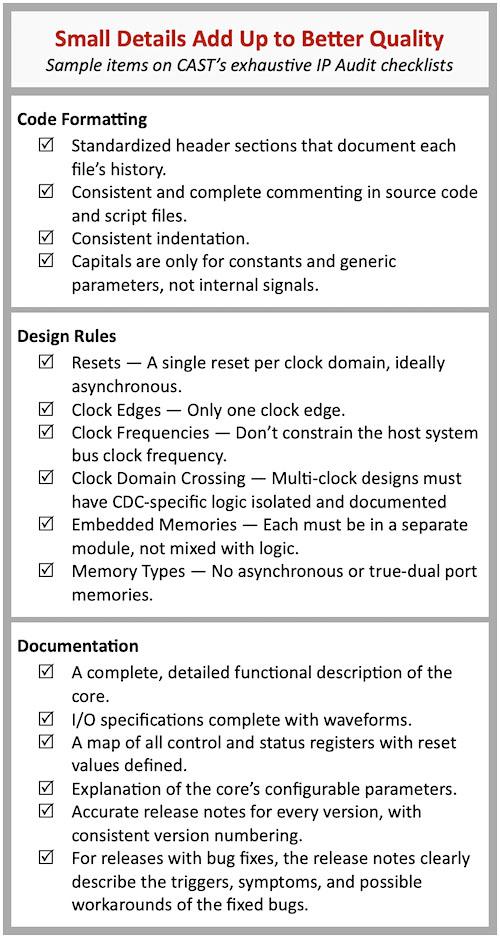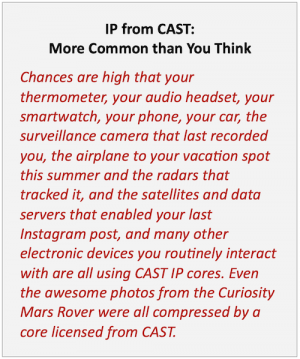Silicon IP Cores
Ensuring IP Quality for a Better IP Experience
For years CAST has focused on giving customers A Better IP Experience.
More than just a slogan, this reflects our dedication to delivering the highest quality IP cores available, making them as easy to use and integrate as possible, and providing outstanding technical support from pre-sales through tape-out.
Here we take a brief look at the steps CAST takes to build excellent IP quality into every IP core we offer:
- Developing an efficient architecture,
- Following best practice coding and design rules,
- Verifying standards conformance and correct functioning, and
- Reducing risk and ensuring customer success.
Quality Starts with the Right Architecture
The ultimate usefulness of a core depends on providing the right set of features and doing so with an innovative, efficient architecture optimized for the intended end use.
This requires experienced system architects who guide the core’s development from initial specification to final verification. CAST’s seasoned IP architects work hand in hand with technology-specific experts—either within CAST or via our long-term partnerships—to jointly develop quality IP across many application areas.
The technology experts have the essential understanding of their domain, whether it's networking, processor design, compression codecs, functional safety, or encryption algorithms. But our architects know how to develop reusable IP. Multi-year experience helps us understand what it takes for a core to be efficient, and to be easy to integrate, verify, and use in the context of our customer’s complex SoCs.
Our architects work along with the technology experts and assist them in making the right design decisions throughout the design and verification cycle. This combination yields some of the best IP cores in the industry.
Quality Demands Consistent Best Practices
Through decades of experience, we’ve developed or adopted best practices for coding IP cores and design rules to ensure they operate correctly.
These practices enable a core to pass smoothly through the tool flow—simulation, synthesis, timing analysis, scan insertion, etc.—and ensure that problems are revealed and addressed early. This avoids expensive (in time and money) iterations at later design stages close to or even after tape-out. These practices also ensure that the source code is easy to review and maintain, and that integration of the core in a system is straightforward and trouble-free.

Enforcing these best practices and design rules across our distributed development team can be a challenge. Positive LINT testing for code style and CDC handling and a successful functional and code coverage analysis are mandatory, as is running every core through a rigorous formal audit process. We have developed this audit over many years, working with dozens of cores and thousands of customers. See the table for some of the audit checks. These measures help ensure the “build quality” of the IP core. But how do we ensure that even a well-architected and coded core does what it is supposed to do?
Quality Requires Exhaustive Verification
The most smartly architected and well- implemented IP core is useless if it doesn’t correctly perform the intended behavior. Verifying that the IP core functions properly and entirely against the relevant industry specification or standard is the most critical part of ensuring IP quality.
It’s also the most challenging.
Processors must support their ISA. Image, video, and data codecs must satisfy their standard specifications. Automotive cores should meet Functional Safety criteria. Cores using standard interfaces such as AMBA® buses—always a good practice—must also conform to those specifications. And so on. And they should do all this correctly without any mistakes under any use scenario.
We take several steps for rigorous IP verification.
The first is following the standardized and widely adopted Universal Verification Methodology (UVM) for all new cores. We strive to make no compromises on functional and code coverage statistics, and this does much to ensure standards conformance, interoperability, and error-free operation.
Comprehensive verification environments are critical. We develop our own, but also employ reliable third-party Verification IP (VIP) when available. (Often we jointly share our design IP with vendors creating VIP for new technologies.) This further minimizes the risk of an oversight or misinterpretation of the specification by the core developers and strengthens our confidence in the robustness of our verification.
We typically complement our simulation-based verification efforts with FPGA prototyping and testing. This allows us to run millions or billions of test vectors against the core—stressing it in different ways and exploring many if not all edge cases.
Reference designs further help assess a core’s ease of integration and operation in environments and tools that are not easy to simulate. We will take such reference design boards to industry “plug fests,” testbeds where multiple vendors interconnect their products in a facsimile of a real-world environment. Finally, we will have applicable cores tested and certified by reputable independent testing houses, such as SGS-TÜV Saar GmbH for functional safety.
Quality Means Reducing Risk
The goal of quality is reducing the customer's risk—perceived and actual—in purchasing and using an IP core. Properly architecting, building, and verifying the core are the essential explicit steps. But the “quality” of the IP provider itself can also reduce risk.
Customers should feel confident that the IP provider:
- has a solid reputation with a proven track record of living up to its claims of functionality and quality for IP in the customer's application domain,
- has the team and experience to provide rapid, effective technical support, and
- will actually remain solvent for the customer product’s development and maintenance lifetime.

Being in business for 30 years, nearly 3,000 CAST customers have together shipped billions of product units. The IP we offer is not just silicon-proven—a popular industry buzzword implying quality—but is actually customer-proven time and time again. Moreover, we back these products with an impeachable reputation for excellent customer support.
These factors significantly reduce the risk of licensing IP from CAST. Combined with the steps outlined above, we ensure that every CAST customer receives high-quality IP, and a better IP experience.
Conclusion: Quality Past and Future
As the IP market started taking off in the late 1990s, hundreds of small and large providers popped up, and the need for quality quickly became obvious.
In 1996, several major firms formed the Virtual Socket Interface Alliance (VSIA) to develop standards for IP. Subsequent efforts at evaluating quality led to the Open Measure of Reuse Excellence (OpenMORE) and then the Quality IP Metric (QIP). While these very formal efforts did not persist, they did set the foundation for some of today’s commonly accepted best practices. They also moved forward a fundamental principle that even today many IP providers fail to adopt: IP is a product, not a service.
At CAST we were part of this process and learned much from it. That lead to our own unwavering dedication to delivering high-quality IP cores, and the pragmatic measures described here by which we ensure this.
When you’re next considering an IP core, think about its quality along the lines outlined here. Challenge the IP provider to prove their domain understanding, reveal their QA audit routines, explain their verification processes, and provide evidence of other customers succeeding with the core
And be sure to also compare the quality IP that we at CAST can provide you.
